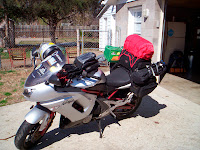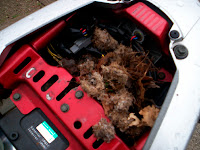Shortly following my return from Tellico Plains, TN in March of this year, my wife and I gave serious consideration to acquiring a new machine. While we talked about owning another motorcycle for several years, the stars did not seem to align in just the right way to turn those discussions into reality. In early April, several changes in our finances gave the first glimmer of hope that the possibility of owning another bike was more than dreaming. We were two months away from paying off the loan on our truck, and six months away from completing the cycle of payments on a new furnace. After reviewing the mechanical and electrical gremlins in the Ninja upon my return from the Smokies, my wife made the comment, "You know, we can probably afford another bike now."
My obsession became like a horse pressing the starting gate. However, before I could begin, my spouse and I established some ground rules for the process.
- I agreed to begin my search using the intergoogle in order to establish distance and availability factors.
- No purchases would be made using the intergoogle.
- No purchase would be finalized without a test ride, whether the machine of interest was new or used.
- A "buy it today or the price will be different tomorrow" attitude from dealers or private sellers would illicit an automatic "Bye!" response from yours truly (preceded usually by a "Hell no!" over the phone by wifey).
- I agreed to remain within the parameters of the basic motorcycle type for which I was obsessing (i.e. not to leave to check out a Concours 14 and return with a Ducati 999).
Having concocted these basic guidelines, the much more difficult question of what exactly we were looking for in a motorbike-for-two needed to be sorted out. Sitting around the kitchen table with some soft jazz in the background, the scent of fresh bread baking in the oven, and the reassurance of a strong cup of coffee, we formulated our list of must-have's.
Wifey's List:
- The bike must be designed for carrying two people.
- The rear seat must be comfortable.
- The bike must be designed to carry things along with the riders.
My wife's requirement of a comfortable pillion comes from her memories of riding two-up on a Harley Sportster in the bygone days of our early courtship. On one such trip around the county in which we lived, a total of no more than 80 miles, she tapped me on the shoulder and shouted into my ear, "Pull over, please. I have to get off this *&%#ing thing."
Lest those readers cry out that my wife should ride her own, let me inform you that up until my crash in 2005 on the Harley, my wife rode beside me on her Honda Rebel 450. After the accident, she never threw a leg over the saddle alone again. She assures me this is not out of fear of riding and hopes to ride her own again in the near future.
My own list of must-have's was a bit more extensive.
- The bike must be designed to carry two passengers.
- The bike must have hard luggage.
- The bike must be "sporty" in it's ride style.
- The bike must have a good reputation for reliability by those who favor the machine (nonexclusive online forums are an excellent place to garner information).
- The bike must have. . . presence. . .(I'll get to this one in a minute).
- Dealership support would be nice, but must be something I can do most of the work on myself.
- While the bike can have. . . presence. . . it must not contribute to my reverting into a knuckle-dragging, boastful, loud and obnoxious piece of greasy societal mayhem.
Presence. I desired a bike that called to me from the garage, a machine that just to look at was a pleasure. Motorcycles with presence turn eyes toward them and cause them to linger, the mind to envision where it will carry you, and the heart to yearn for the road. It's arguable that all motorbikes have presence, and I would certainly agree. But some exude more of this quality than others. For instance, since the first time I ever laid eyes on one, I've coveted a Triumph Speed Triple. Why? The machine would be completely impractical for my needs. There's no room for a passenger or any real luggage, no shielding of any kind from the elements of the road, far more power than I can responsibly use on public roadways. What is it about that bike that causes my blood to race even while the bike is standing still? Because it's a muscle with two wheels attached, fire and iron and little else. It appeals to my basic animal nature and nothing more. And in the realm of desire and obsession, as a selling point, no more is required.
But the presence I wanted during the misty mornings of April appealed to a higher nature. I wanted a bike that just by gazing at it, transported me to places far from home. In that vision, I could crawl free of a tent heavy with dew, gear up, and move off through Kentucky hill country as the wispy vapor of early morning fog rises from damp fields and stands of pine. I wanted a machine that could accomplish this day after day after day without complaint, a motorcycle that aligned the compass of my spirit toward the horizon.
The list I crafted hunkered down at my kitchen table during a chilly Spring evening looked like this.

Kawasaki Concours 14

Suzuki V-Strom 1000

Moto Guzzi Norge

Honda VFR

Kawasaki Concours 1000

Harley-Davidson Electra Glide
I began to lean heavily toward the Concours 1000 after several days of thought. While that edition of the iconic sport-tourer was replaced by the 2008 Concours 14, the elder of the model line still commands a loyal following. Reports of it's reliability are legendary. Well, legendary among Concours owners, anyway. It has a big, comfortable seat and locking hard luggage. My thought was that I could spend half as much for a used Concours 1000 as I would on the 14 or the V-Strom, have a reliable bike, and save some money for farkles. So that was it, my mind made up, I began the quest for a gently used Kawasaki Concours 1000 that would carry me across four states.
OK. So the Harley's on the list purely for shits and giggles. While I'm sure the Electra Glide carries two passengers in comfort and it certainly has presence, it pushes the definition of "sporting" ride. Speaking only for myself, of course, I also risk a return to the draggery of the knuckles stage of my existence. Once my leg was over the saddle, I'd probably mutter something about "throbbing power between my legs" or some such nonsense. Besides, it's a wee tad out of my price range. . .new or used.
While the VFR, I'm sure, is a marvelous piece of modern motorcycle engineering, it fell off the list for two reasons. Look at the rear seat. . . er. . .perch on that thing. My wife would get a nose bleed. It was also a bit above what I was willing to spend for a new or new-to-me machine. And then there's the technical know how necessary to maintain a dual-clutch, throttle by wire. . . wait, that's three reasons. Moving right along.
The Moto Guzzi dazzles my eye every time I look at it. It looks put together right in all the right ways. Price range, even used, would be at the upper limit but affordable. But let's try a little experiment, shall we? Go out your front door, get on your cycle, and ride across town to the Guzzi dealership. What's that? Don't have one? Really? I'm convinced that locating a Moto Guzzi dealer requires membership in some exclusive club. The dues? How about your soul or maybe just your left testicle? Let's not even talk about what happens if you have no testicles.
That leaves the Kawi's and the V-Strom. The description of the Concours 14 says "variable valve timing" among other engine oddities. Guess what happens when I try to get in there with a wrench? Busted, that's what happens. The first Kawi with a check engine light. No thank you.
No offense to V-Strom owners. I've heard wonderful things about the V and the Wee, but both are as pleasant to the eye as a bag of baby puke. But you know what they say, "Beauty is in the eye of the V-holder". To each his own; presence comes in many forms.
I began to lean heavily toward the Concours 1000 after several days of thought. While that edition of the iconic sport-tourer was replaced by the 2008 Concours 14, the elder of the model line still commands a loyal following. Reports of it's reliability are legendary. Well, legendary among Concours owners, anyway. It has a big, comfortable seat and locking hard luggage. My thought was that I could spend half as much for a used Concours 1000 as I would on the 14 or the V-Strom, have a reliable bike, and save some money for farkles. So that was it, my mind made up, I began the quest for a gently used Kawasaki Concours 1000 that would carry me across four states.







